10th CE Chakrapani Temple Kumbakonam
The Chakrapani Temple is a Hindu temple dedicated to the god Vishnu, located in Kumbakonam, Tamil Nadu, India. It is one of the most important Vishnu temples in Tamil Nadu, and is known for its beautiful architecture and intricate sculptures.
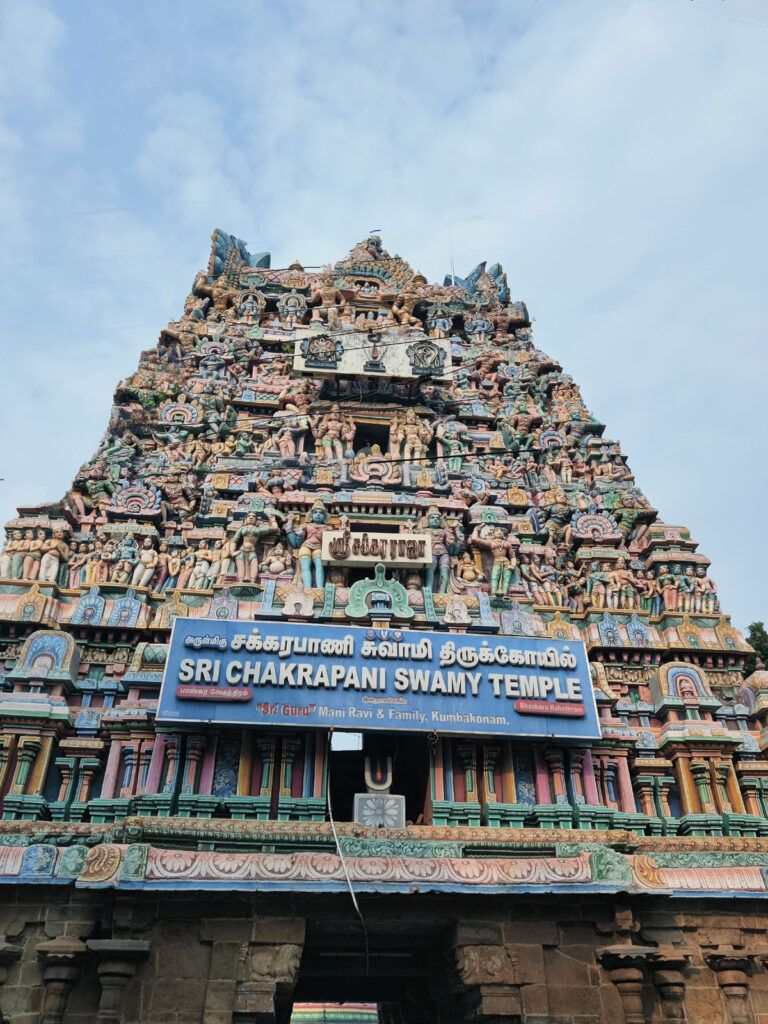
Contents
- 1 History of Chakrapani Temple Kumbakonam:
- 2 Legend of Chakrapani Temple Kumbakonam:
- 3 Significance of Chakrapani Temple Kumbakonam:
- 4 Myths and Beliefs of Chakrapani Temple Kumbakonam:
- 5 Chakrapani Temple Timing and Pooja:
- 6 Festivals at Chakrapani Temple:
- 7 Architecture of Chakrapani Temple Kumbakonam:
- 8 Speciality of Chakrapani Temple kumbakonam:
- 9 Places to visit near Chakrapani Temple Kumbakonam:
- 10 FAQ:
- 11 How to reach Chakrapani Temple:
- 12 Google Maps:
History of Chakrapani Temple Kumbakonam:
The temple is believed to have been built in the 10th century by the Chola king Aditya I. However, there is evidence that the temple may be older, dating back to the Pallava period.
Chakrapani Temple is located on the banks of the Cauvery River. The main deity of the temple is Vishnu, who is worshipped in the form of Chakrapani, or “the one who holds the discus.” The discus is a symbol of Vishnu’s power and protection.
The temple is said to have been built by the sage Agastya, who is credited with bringing the Vedic tradition to South India. The sage is said to have installed the image of Vishnu in the temple.
The temple is also associated with the story of Jalandharasura, a demon who was killed by Vishnu. Vishnu is said to have used his discus to kill the demon, and the discus is said to have landed at the site of Chakrapani Temple.
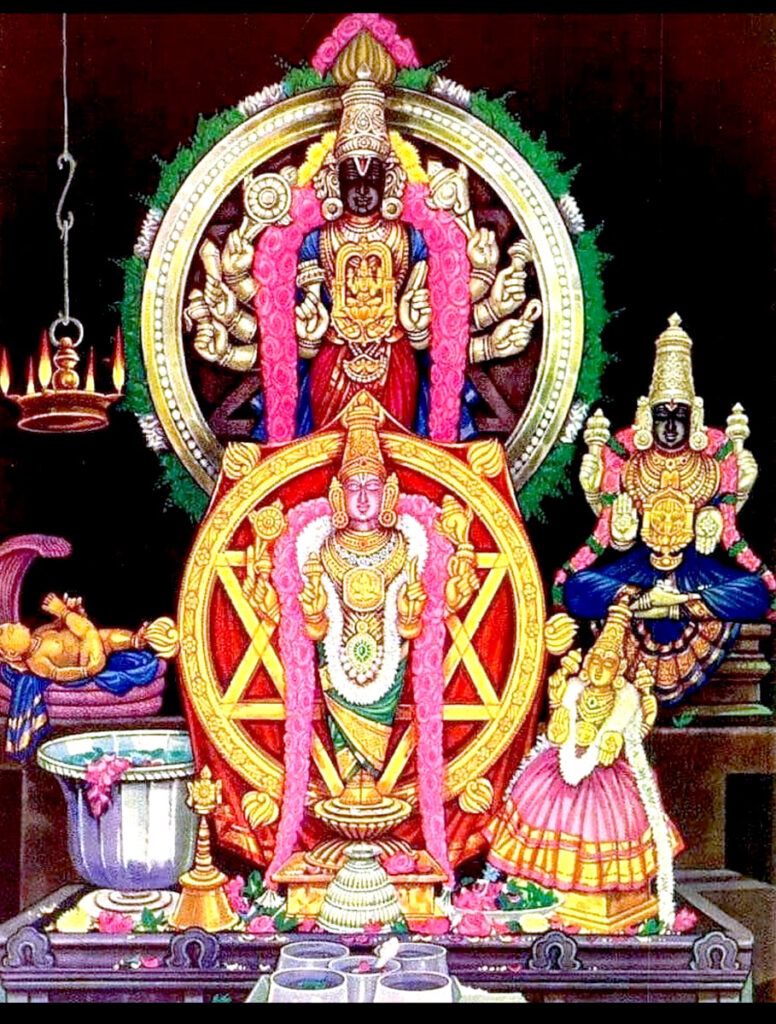
Legend of Chakrapani Temple Kumbakonam:
According to the legend, there once was a demon named Jalandharasura who was terrorizing the world. He was so powerful that even the gods were afraid of him.
The gods turned to Vishnu for help. Vishnu agreed to help, and he sent his Sudarshana Chakra, a discus that could cut through anything. The Chakra pierced Jalandharasura’s heart, and he was killed.
The Chakra then fell to earth and landed on the banks of the Cauvery River. The sun god, Surya, was bathing in the river when he saw the Chakra. He was so impressed by the Chakra’s power that he decided to build a temple to Vishnu.
Surya built the temple on the spot where the Chakra had landed. He also installed the Chakra in the temple as the main deity.
The temple became known as the Chakrapani Temple, and it is one of the most important Vishnu temples in South India.
The legend of Chakrapani Temple is a reminder of Vishnu’s power and his willingness to help those in need. It is also a reminder of the importance of devotion to God.
Here are some additional details about the legend:
- The Chakra is said to have been made of a special metal that could not be melted or destroyed.
- The temple is located on the banks of the Cauvery River, which is considered to be a sacred river in Hinduism.
- The sun god, Surya, is considered to be a devotee of Vishnu.

Significance of Chakrapani Temple Kumbakonam:
The temple is dedicated to Vishnu in his form as Chakrapani, the Lord of the Discus. The discus is Vishnu’s most powerful weapon, and it is said to be able to destroy evil and protect the innocent.
The temple is also home to a shrine to the Sun God, Surya. Surya is said to be a manifestation of Vishnu, and he is worshipped at the Chakrapani Temple for his blessings of health, prosperity, and success.
The temple is believed to have powers to cure diseases and ailments. Devotees who visit the temple often pray for healing, and many believe that their prayers are answered.
Myths and Beliefs of Chakrapani Temple Kumbakonam:
The Chakrapani Temple in Kumbakonam is a sacred place for Hindus, and it is associated with a number of myths and beliefs. Here are some of the most notable myths and beliefs associated with the temple:
- The legend of the temple tells how Vishnu appeared in the form of a discus to subdue the arrogance of Surya, the sun god. Surya had become arrogant and was causing trouble for the gods and humans. Vishnu defeated Surya and restored order to the world, and he became known as Chakrapani from then on.
This myth is reflected in the Chakrapani temple’s architecture. The main sanctum sanctorum of the temple houses a statue of Vishnu in his Chakrapani form. The statue is depicted holding a discus in one hand and a conch shell in the other. The discus represents Vishnu’s power and authority, while the conch shell represents his victory over Surya.
- The temple is associated with the Mahamaham festival, which is a major Vaishnava festival that is held every 12 years in Kumbakonam. The festival is said to commemorate the event of Vishnu appearing as Chakrapani.
During the Mahamaham festival, the temple is visited by millions of devotees from all over India. The festival is a time of great celebration and devotion, and it is believed that bathing in the Mahamaham Tank during the festival can cleanse one of all sins.
- The temple is also associated with a number of other myths and beliefs. For example, it is said that the temple is home to a sacred stone that can grant wishes. It is also said that the temple is a place of healing, and that devotees who come to the Chakrapani Temple with faith can be cured of their diseases.
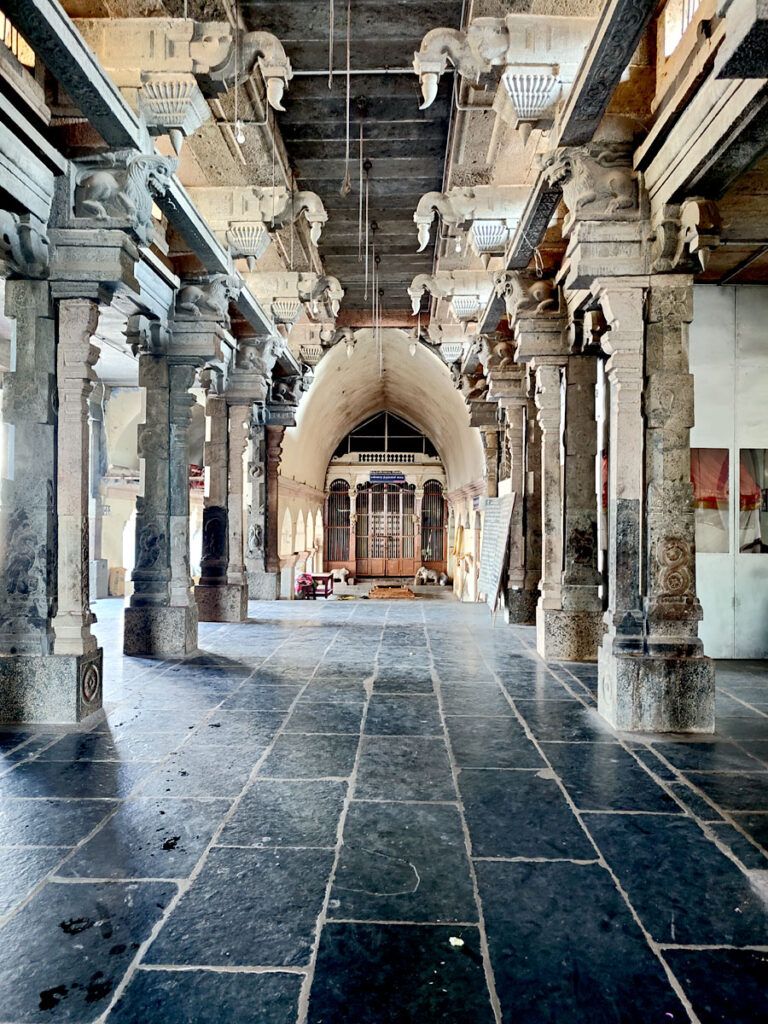
Chakrapani Temple Timing and Pooja:
The temple is open from 6:00 AM to 12:30 PM and from 4:00 PM to 9:00 PM.
Poojas
The following are the daily poojas offered at the Chakrapani Temple:
- Usha Kala Pooja: This pooja is offered in the morning at 6:00 AM.
- Ezhuththu Pooja: This pooja is offered in the morning at 7:00 AM.
- Usha Nandi Pooja: This pooja is offered in the morning at 7:30 AM.
- Mahamangalarathi: This pooja is offered in the evening at 7:00 PM.
- Sunset Pooja: This pooja is offered in the evening at 7:30 PM.
- Aaradhanai: This pooja is offered in the evening at 8:00 PM.
Festivals at Chakrapani Temple:
Brahmotsavam: This 10-day festival is held in the Tamil month of Chithirai (April-May). It is the most important festival of the temple and is celebrated with a grand procession of the deity, along with other rituals and ceremonies.
Theppootsavam: This floating festival is held in the Tamil month of Vaikasi (May-June). The deity is taken in a procession to the river Cauvery and then placed on a floating platform. The platform is then taken around the river in a procession.
Pavitrotsavam: This festival of purification is held in the Tamil month of Aani (June-July). It is a time for the Chakrapani Temple to be cleaned and purified, and is also a time for devotees to come and take a dip in the river Cauvery.
Cakrayudha Utsavam: This festival is held in the Tamil month of Thai (January-February). It is a time to worship Vishnu as the wielder of the discus, or chakra. The festival includes a procession of the deity, along with special prayers and rituals.
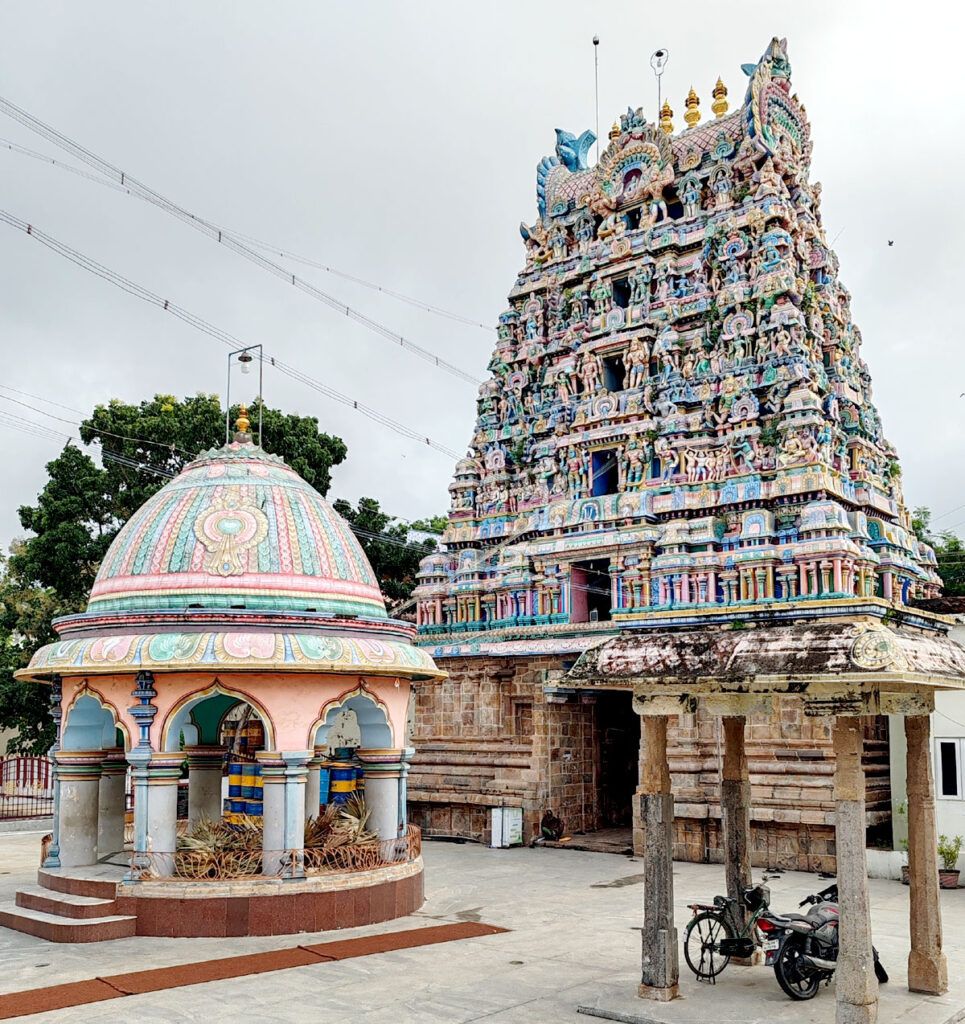
Architecture of Chakrapani Temple Kumbakonam:
The temple is built in the Dravidian style of architecture, and is made of granite. The main temple complex is surrounded by a large moat, and is entered through a grand gateway. The gateway is decorated with sculptures of gods and goddesses, as well as elephants and lions.
The inner sanctum of the Chakrapani Temple houses the main deity, Chakrapani Perumal. Chakrapani Perumal is depicted as a standing Vishnu, holding the Sudarshana Chakra in his right hand. The Sudarshana Chakra is a discus that is said to be a powerful weapon of Vishnu.
The temple also houses a number of other shrines, dedicated to other deities, including Lakshmi, Hanuman, and Garuda. The temple also has a number of tanks and wells, which are used for religious purposes.
The Chakrapani Temple is a popular pilgrimage destination, and is visited by Hindus from all over the world. The temple is also a popular tourist destination, and is known for its beautiful architecture and intricate carvings.
Here are some of the architectural highlights of the Chakrapani Temple:
- The gateway: The gateway is the most impressive part of the temple complex. It is decorated with sculptures of gods and goddesses, as well as elephants and lions. The gateway is also decorated with intricate carvings of flowers, leaves, and vines.
- The inner sanctum: The inner sanctum is where the main deity, Chakrapani Perumal, is housed. The sanctum is decorated with beautiful paintings and sculptures. The ceiling of the sanctum is decorated with a depiction of Vishnu’s abode, Vaikuntha.
- The shrines: Chakrapani Temple also houses a number of other shrines, dedicated to other deities. These shrines are also decorated with beautiful paintings and sculptures.
- The tanks and wells: The temple also has a number of tanks and wells, which are used for religious purposes. These tanks and wells are also decorated with beautiful carvings.
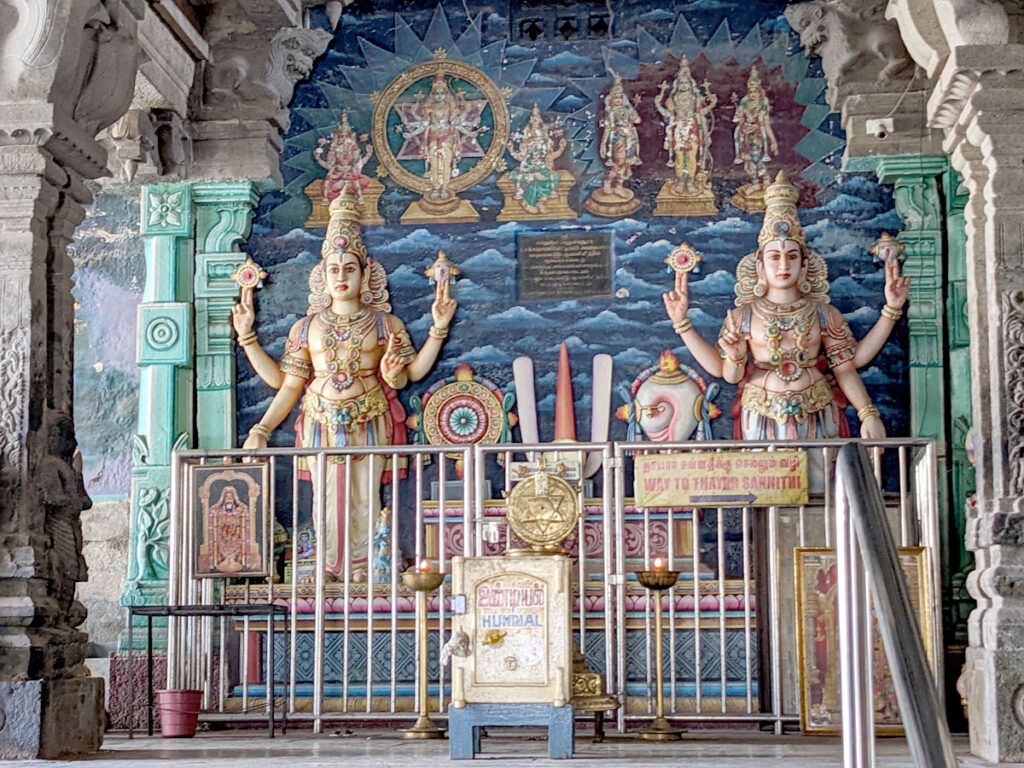
Speciality of Chakrapani Temple kumbakonam:
The presiding deity of the temple is Vishnu in his Chakrapani form. Chakrapani means “the one who holds the discus,” and the discus is a divine weapon associated with Vishnu. Vishnu is often depicted holding the discus in his hand, and he is sometimes referred to as Chakrapani.
The legend of the temple tells how Vishnu appeared in the form of a discus to subdue the arrogance of Surya, the sun god. Surya had become arrogant and was causing trouble for the gods and humans. Vishnu defeated Surya and restored order to the world, and he became known as Chakrapani from then on.
Chakrapani Temple is associated with the Mahamaham festival, which is a major Vaishnava festival that is held every 12 years in Kumbakonam. The festival is said to commemorate the event of Vishnu appearing as Chakrapani.
Places to visit near Chakrapani Temple Kumbakonam:
- Mahamaham Tank: This is a large temple tank located in Kumbakonam itself, known for its religious significance. The Mahamaham festival, which occurs once every 12 years, attracts a large number of pilgrims to this tank.
- Adi Kumbeswarar Temple: This is another prominent temple in Kumbakonam dedicated to Lord Shiva. The temple has beautiful architecture and is an important pilgrimage site.
- Sarangapani Temple: Located in Kumbakonam, this temple is dedicated to Lord Vishnu and is one of the Divya Desams, the 108 temples of Lord Vishnu revered in the Vaishnavism tradition.
- Nageswaran Temple: This ancient temple is dedicated to Lord Shiva and is known for its architectural beauty. The temple has intricate carvings and is worth a visit for its historical and religious significance.
- Darasuram Airavatesvara Temple: A UNESCO World Heritage Site, this temple is a masterpiece of Chola architecture. The intricate carvings and the well-preserved structure make it a must-visit for history and architecture enthusiasts.
- Swamimalai Murugan Temple: Located a bit further away, this temple is dedicated to Lord Murugan, the son of Lord Shiva. It is one of the six abodes (Arupadaiveedu) of Lord Murugan and is situated on a hill.
- Thiruvarur: About 30 kilometers from Kumbakonam, Thiruvarur is known for its Thyagaraja Temple dedicated to Lord Shiva. The temple has a beautiful rajagopuram and is a significant pilgrimage site.
- Gangaikonda Cholapuram: This historical site is known for the Brihadeshwara Temple, built by Rajendra Chola I. The temple is dedicated to Lord Shiva and reflects the architectural grandeur of the Chola dynasty.
- Kumbakonam Temples Circuit: Apart from individual temples, Kumbakonam is known for its temples circuit, and you can explore various temples, each with its unique significance.
FAQ:
Q: Where is the Chakrapani Temple located?
A: The Chakrapani Temple is located in Kumbakonam, Tamil Nadu, India. It is situated on the banks of the Cauvery River, about 2 kilometers northwest of the Kumbakonam railway station.
Q: Who is the presiding deity of the Chakrapani Temple?
A: The presiding deity of the Chakrapani Temple is Vishnu, who is worshipped in the form of Chakrapani. Chakrapani means “the one who holds the discus.” The discus is a weapon that is associated with Vishnu.
Q: What is the legend associated with the Chakrapani Temple?
A: According to the legend, Vishnu appeared in the form of a discus to subdue the arrogance of Surya, the sun god. Surya had become arrogant and was causing trouble for the gods and humans. Vishnu defeated Surya and restored order to the world.
Q: What are the important festivals celebrated at the Chakrapani Temple?
A: The most important festival celebrated at the Chakrapani Temple is the annual Karthigai Deepam festival. This festival is celebrated in the month of Karthigai (November-December) and is dedicated to Vishnu.
Q: What are the other temples located near the Chakrapani Temple?
A: There are several other temples located near the Chakrapani Temple. These include the Sarangapani Temple, the Patteeswarar Temple, and the Ramaswamy Temple.
Few more FAQ:
What is the time period of Chakrapani?
The Chakrapani Temple in Kumbakonam is believed to be of significant antiquity. The oldest parts of the temple are thought to date back to the Chola period (8th-12th centuries CE). However, the temple has been renovated and added to over the centuries, and it now includes elements from the Vijayanagara Empire (14th-16th centuries CE) and the Madurai Nayak period (16th-18th centuries CE).
Who built Chakrapani temple?
The exact builder of the Chakrapani Temple in Kumbakonam is unknown. However, the oldest parts of the temple are thought to date back to the Chola period (8th-12th centuries CE). The Cholas were a powerful dynasty that ruled much of southern India during this period. They were known for their patronage of Hinduism and for their construction of many beautiful temples.
It is possible that the Chakrapani Temple was built by the Cholas, but it is also possible that it was built by a later dynasty. The temple has been renovated and added to over the centuries, and it now includes elements from the Vijayanagara Empire (14th-16th centuries CE) and the Madurai Nayak period (16th-18th centuries CE).
The most recent additions to the temple were made in the 17th century by Govinda Dikshitar, a diwan-administrator for the Nayaks. Dikshitar added a commercial corridor between the new Ramaswamy Temple and the older Chakrapani Temple.
Where does the name Chakrapani come from?
The name “Chakrapani” comes from the Sanskrit words “chakra” (discus) and “pani” (hand). It means “one who holds the discus.” The discus is a divine weapon associated with Vishnu, one of the principal deities of Hinduism. Vishnu is often depicted holding the discus in his hand, and he is sometimes referred to as Chakrapani.
In the case of the Chakrapani Temple in Kumbakonam, the name is particularly apt because the presiding deity of the temple is Vishnu in his Chakrapani form. The legend of the temple tells how Vishnu appeared in the form of a discus to subdue the arrogance of Surya, the sun god. Surya had become arrogant and was causing trouble for the gods and humans. Vishnu defeated Surya and restored order to the world, and he became known as Chakrapani from then on.
The name “Chakrapani” is also a reminder of the temple’s association with the Mahamaham festival, which is a major Vaishnava festival that is held every 12 years in Kumbakonam. The festival is said to commemorate the event of Vishnu appearing as Chakrapani.
How to reach Chakrapani Temple:
By Air:
The nearest major airport is Tiruchirapalli International Airport (IATA: TRZ), which is approximately 91 kilometers away from Kumbakonam. Once you arrive at the airport, you can hire a taxi or use other local transportation to reach Kumbakonam.
By Train:
Kumbakonam has a railway station, and the town is well-connected by rail. You can check the train schedules and book tickets to Kumbakonam Railway Station. From the railway station, you can hire a taxi or use local transportation to reach Chakrapani Temple.
By Road:
If you prefer traveling by road, Kumbakonam is well-connected by a network of roads. You can reach Kumbakonam by bus or private vehicle. Once you reach Kumbakonam, you can hire a taxi or use local transportation to get to the Chakrapani Temple.
Local Transportation in Kumbakonam:
Once you are in Kumbakonam, you can use local transportation options like auto-rickshaws, cycle rickshaws, and taxis to reach the Chakrapani Temple. Most locals are familiar with the prominent temples, so you can ask for directions.

2 Comments